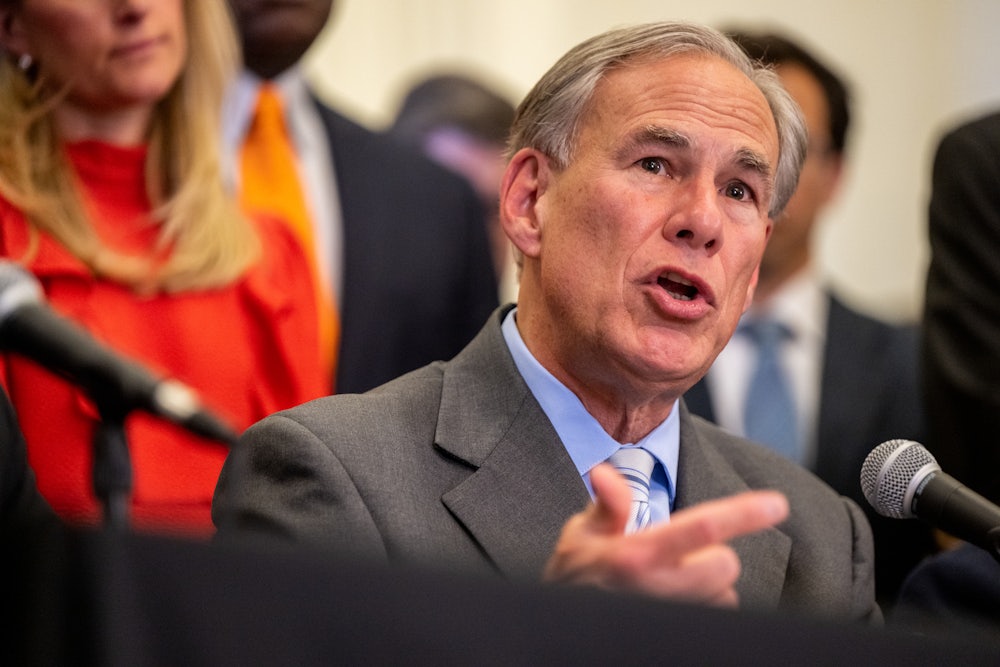On March 15, the Texas Education Agency, or TEA, confirmed to the public that it plans to forcibly remove the Houston Independent School District’s democratically elected superintendent and board of trustees in June, effectively seizing control of its 276 schools and nearly 200,000 students. The decision came after four years of protracted legal battles, during which time test scores in Houston ISD schools improved overall, but the move ticked along to a different clock: By coincidence, it happened to dovetail nicely with Republican Governor Greg Abbott’s “Parent Empowerment Tour”—a series of speaking engagements at wealthy Protestant private schools where he’s touted the supposed “educational freedom” offered by school vouchers and cast fears about “the woke agenda.”
Even as campaign platitudes like “school choice” seem to imply a certain amount of local control, Abbott’s move has signaled that he’s willing to thrust his administration into possession of his state’s largest school district. If this sounds eerily similar to Ron DeSantis’s war on “woke” initiatives, that’s because it is. In fact, it’s a running joke among some Texas state Capitol insiders that if you want to know what policies Greg Abbott will likely enact, you should study the front pages of The Miami Herald. But whether the two governors are competing for the affection of their Republican constituents isn’t as important as—they’re both often quick to say—the kids.
Carlos Alvarado is a 17-year-old junior at Furr High School, a large, gated complex caught in an elbow chokehold between Interstate 10 and U.S. Route 90 on Houston’s far east side. The school, which received a C rating from TEA based on attendance, dropout rates, and economically disadvantaged “risk factors,” is responsible for around 1,100 students, nearly 80 percent of whom are Hispanic and 18 percent are Black. Sometimes, Alvarado told me, the school bus just doesn’t show up. “Even though I live seven minutes away from my high school, I don’t have a bus to go to school all the time.” He said his English class has around 35 students, but only 24 desks. When students are absent for whatever reason—the bus doesn’t show up, or they have to choose work over school to help out their families—sometimes everyone present is able to sit at their own desk.
For years, Houston ISD has awarded money to schools based on attendance. At the end of each year, a school with 95 percent attendance will receive around $50,000 less than a school with 98 percent attendance. In 2019, more than 20 percent of students at Furr were chronically absent. There are, of course, other funding opportunities provided to schools that tend to low-income students, but Houston ISD is also categorized by the state as a property-wealthy district, meaning it actually has to send money back to the state to help fund other poorer districts. Houston schools that are already disadvantaged based on scarcity are further punished for problems arising from that scarcity, while more affluent schools down the road are some of the best in the state. When schools receive a low score, it drives down property values—on and on the vicious cycle spins.
A 2015 state law says that if a school district has a campus with a failing TEA-anointed grade for five consecutive school years, the commissioner is required to appoint a board of managers or close the campus. But it was only one school—the historically Black Phillis Wheatley High School, about eight minutes from Furr along I-10—that hit this benchmark in 2019. Furr and Wheatley are both surrounded by charter schools, which The Texas Observer reported has resulted in a decline in enrollment. Today, Wheatley has a C rating, the same as Furr’s, but the wheels were already in motion, and now the takeover is imminent.
Over the years, evidence has piled up suggesting that these kinds of school takeovers are ineffective and that the primacy of standardized tests constrains schools to “teach for the test”—forcing teachers to achieve arbitrary scores to maintain their good standing. Meanwhile, the charter schools pitched as a remedy are often “intensely segregated settings,” according to a 2010 UCLA Civil Rights Project study. In Texas, more charter school districts than public school districts received an F accountability rating from the TEA, according to The Texas Observer. But school choice isn’t really about any of these things.
At the TEA’s takeover announcement, Commissioner Mike Morath said, “Even with recent improvements, and despite good intentions from many, Houston ISD as a system continues to allow chronically low achievement in multiple schools.” In 2022, the TEA gave Houston ISD a B ranking, above 611 other school districts or charter campuses, including the state’s second largest, Dallas ISD. In Morath’s view, “State intervention is necessary” to “shore up support for students in those schools.” But state intervention to what end? Before he was TEA commissioner, Morath, an evangelical tech entrepreneur, was a school board trustee in Dallas, where in 2014 he was the face of the “home rule charter” movement, an effort by business leaders (including John and Laura Arnold of Arnold Ventures, who recently helped open a nonprofit newsroom in Houston) to convert the entire school district into what amounts to a charter school system. Had this project succeeded, it would have removed school board elections entirely, as well as the safeguards on teachers’ jobs, making them easier to hire and fire. At the time, Alliance AFT, the teacher group with the largest membership in Dallas ISD, called it a “power grab.” Eventually, the plot fizzled. A year later, in 2015, Morath jumped from his position on the school board to become Abbott’s TEA commissioner.
“The entire American schooling system is predicated on students having no agency over their time in schools, what they do, and what they prioritize,” said Uyiosa Elegon, an activist in Houston who started organizing in high school around a lack of funding across the district. He was one of the early members of the Houston ISD Student Congress, a group that formed in 2014 to bolster student voices in school board meetings and citywide decision-making when it comes to education. (Alvarado is a current member of this organization.) “We need to do everything imaginable to get away from the language of good school/bad school, failing school/passing school. We know property values in predominantly Black and brown, low-income neighborhoods are not fairly estimated or valued,” he said, and the same goes for schools. For this reason, Elegon has advocated for lowering the voting age to 16 so school boards see students not as a data and test score problem to be solved but as constituents with legitimate concerns. He asked me, “Can you imagine what it would look like for a school board member to have no choice [but] to make sense to young people during their campaigns?”
Student and teacher labor combined produces the data used to allocate billions of dollars in Texas. For as long as there have been conflicts in Houston ISD, students have organized to remind people of that fact. After the 1954 Brown v. Board of Education Supreme Court decision outlawed segregation in schools, Houston’s leaders dragged their feet, only integrating one grade per year. To reach court-ordered integration numbers in the late 1960s, Houston ISD categorized Hispanic students as “white” and siphoned them into majority-Black schools. By 1970, its schools were finally desegregated, at least in an official sense, but Houston’s neighborhoods and economy were still the most segregated of any major American city at the time.
In September 1969, the majority-Hispanic students at Jefferson Davis High School (renamed Northside High School in 2016) walked out to protest conditions at their school and the surrounding poverty in their community. Their demands were similar to those around the country at the time, including courses on Chicano history, hiring more Chicano teachers and counselors, and lengthening lunch breaks. But there were less typical practices they wanted to end as well: One, known as “pushouts,” involved counselors advising certain students to drop out in order to maintain “order” in the classroom. These students also sought to eliminate the public posting of “pregnancy lists,” which the administration used to shame pregnant students who had to leave school. The question of local control mattered in these battles, as well, as students sought a deeper and more democratic process to govern their own education and how money was allocated to further it.
For decades afterward, the Houstonian status quo bickered over keeping education tax rates low, and school board trustees denied the true extent of the district’s segregation. (In 1987, the Houston Chronicle reported that the high concentration of Hispanic classrooms was “caused more by demographic makeup than lax desegregation efforts.”) They were trying to tamp the gaping wound with so many Band-Aids. In the mid-1990s, as the charter school movement began to gather steam nationally, then-superintendent and future education secretary to the Bush administration Rod Paige ushered in sweeping changes that would later be the model for the 2001 nationwide No Child Left Behind Act. Paige took the carrot-and-stick approach loved by austerity hawks: Principals were subject to one-year “performance contracts” modeled after the private sector, which removed due process and tenure rights from their job descriptions, and private schools were contracted to take in hundreds of students to deal with “overcrowding.”
Like many Republican politicians today, Paige often touted the merits of school choice, denigrated teachers unions, and made a point of emphasizing personal responsibility over real material factors that often affect education. In 2004, it came out that some of the key statistics that made Paige’s “Texas miracle” in Houston so attractive—low dropout rates, sky-high test scores—were, in fact, largely the product of cooked books. But the carrot-and-stick rationale remains, and it continues to play out at schools like Wheatley and Furr, further affecting education in the still largely segregated areas of the city.
Alvarado told me one day he wants to be a doctor, a cardiothoracic surgeon in fact. He understands the challenge of getting into medical school and earning a residency. But he feels it will be worth it. He works hard in school and already has a couple internships under his belt. Or, he said, he wants to be a lawyer. Or maybe mathematics. He hasn’t decided yet. And why should he? He told me matter of factly, “It’s a lot of school I want to go to.” But the power to ensure he has all the tools to do so hangs in the balance.
The impact of these power exertions to come won’t be felt right away, but a long shadow has already been cast over the Houston Independent School District. Just as DeSantis’s planned university takeover hearkens back to Red Scare–style anti-communism, local control in Abbott’s hands reeks of old-guard segregation combined with a stunted market logic: schools as corporate businesses. And while Houston ISD does have obvious problems that need to be fixed, for years local students have been asking for a greater say in the decisions made on their campuses, not unilateral state decrees on their behalf. The terrifying part of TEA takeovers like this isn’t just that they stand to change the nature of public schooling for years to come, it’s that, usually, many of those changes have already taken place—they’re already affecting outcomes, with or without state intervention—and it just takes a small, autocratic nudge to push them over the edge.










